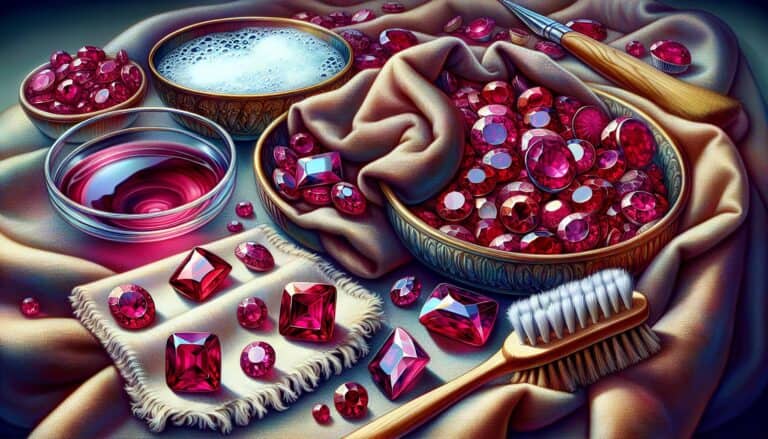Unearthing the secrets of gemstones can be as thrilling as discovering buried treasure.
You’re about to dive into the world of chrysoberyl, a gem often mistaken for other stones due to its dazzling allure. But don’t be fooled; chrysoberyl has unique characteristics that set it apart.
Knowing how to identify chrysoberyl is key to becoming a savvy gem enthusiast or a prudent investor.
You’ll learn the telltale signs that distinguish this gem from its look-alikes, ensuring you’re equipped with the knowledge to spot the real deal.
To identify chrysoberyl, look for its high hardness of 8.5 on the Mohs scale, distinct pleochroism showing different colors from various angles, and a vitreous luster. Genuine chrysoberyl often contains no visible inclusions and has a specific gravity of 3.5 to 3.84.
How to Identify Chrysoberyl Through Testing
Visual Inspection
Start your gemstone’s examination by looking closely at its physical attributes. Chrysoberyl often displays pleochroism, which means it shows different colors when viewed from various angles. You’ll typically see hues of green and yellow. Check for a vitreous to subadamantine luster, which is a telltale sign of chrysoberyl.
The Streak Test
Drag the gem across a piece of unglazed porcelain to observe the streak color it leaves behind. Chrysoberyl will typically leave a white streak, helping you rule out other gemstones that leave colored streaks.
Magnet Test
Although not foolproof, the magnet test can provide clues. Since chrysoberyl has a weak magnetic response due to traces of iron, bringing a strong magnet near the stone might produce a slight attraction. Be cautious – this test is not definitive on its own.
Hardness Test
Employing the Mohs scale of hardness, you’ll find that chrysoberyl ranks 8.5. This means it’s capable of scratching quartz but not corundum. A hardness test kit lets you scratch test your gemstone safely.
Birefringence Test
Chrysoberyl possesses birefringence, or the ability to refract light into two different paths, creating a double image of anything viewed through the stone. Using a dichroscope can help you spot this characteristic feature easily.
Checking The Diaphaneity
Examine the transparency of your gem. Chrysoberyl ranges from transparent to translucent. If your stone isn’t at least translucent, it’s likely not chrysoberyl.
Single or Double Refraction
Chrysoberyl is known for being anisotropic, meaning it has double refraction. By looking down the lengths of the crystal, you should detect two distinct light rays or images.
Refractive Index Test
A refractometer can provide accurate measurements of the gemstone’s refractive index. For chrysoberyl, you’re looking for readings between 1.745 and 1.755. If the measurements fall outside of this range, your stone might not be authentic.
Finding The Specific Gravity
The specific gravity of a chrysoberyl ranges from 3.5 to 3.84. Weigh your gem in air and then suspended in water to calculate its density, which will help confirm its identity.
Identifying Chrysoberyls in the Field
When hunting for chrysoberyl in its natural setting, you’re looking for rough crystals that show good crystal form. These can be six-sided prisms or tabular shapes. Search in regions known for producing chrysoberyl, such as Sri Lanka or Brazil.
Recognizing Potential Chrysoberyl Rocks
Chrysoberyl can often be found in mica schists and granitic rocks. Inspect the area for these rock types. If you find a stone with the described visual and physical characteristics embedded within these rocks, there’s a chance you’ve discovered chrysoberyl.
Physical Characteristics of Chrysoberyl

When you’re out in the field or assessing a stone in your collection, physical characteristics can be key indicators of chrysoberyl. Recognized for its durability, chrysoberyl has a Mohs hardness of 8.5, which means it’s quite scratch-resistant. If you’re testing a sample, bear in mind that only materials of equal or greater hardness can scratch chrysoberyl.
The stone’s luster ranges from vitreous to sub-adamantine, giving it a bright and reflective appearance. This shine can be a telltale sign when you’re comparing chrysoberyl to less lustrous stones.
Regarding color, chrysoberyl comes in various hues from green to yellow and brown. Some chrysoberyl stones exhibit color change under different lighting conditions, shifting from greenish in natural light to reddish under incandescent light. This phenomenon is particularly associated with alexandrite, a variety of chrysoberyl highly prized for its dramatic color change.
| Characteristic | Description |
|---|---|
| Hardness | 8.5 on the Mohs scale |
| Luster | Vitreous to sub-adamantine |
| Color Variations | Green, yellow, brown |
| Color Change Variety | Alexandrite, shifts from green to red under different lights |
Chrysoberyl’s density, or specific gravity, typically falls between 3.5 to 3.8. This is another metric that can help distinguish it from other minerals when conducting a specific gravity test. In terms of crystal structure, chrysoberyl crystallizes in the orthorhombic system, featuring prismatic crystals with straight, parallel striations on some crystal faces. This structural trait can greatly assist in identification, particularly when combined with a well-informed visual examination.
How Are Chrysoberyl Formed?
Chrysoberyl is a beryllium-aluminum oxide mineral that forms in pegmatites and metamorphic rocks. Pegmatites are the primary source, offering the perfect environment due to their late-stage cooling process. This slow cooling allows for large crystals to grow, and it’s here that chrysoberyl begins to take shape. Additionally, when continental plates collide, the increase in pressure and temperature can metamorphose beryl-containing rocks into chrysoberyl.
The key components needed for chrysoberyl formation are beryllium and aluminum. These elements are often sourced from rocks rich in feldspar and beryl. Beryllium is typically scarce, making locations that have the right geochemical conditions quite unique.
- Geochemical Conditions: Presence of beryllium and aluminum is crucial.
- High Temperature and Pressure: Necessary for the metamorphosis from beryl-containing rocks.
- Cooling Rates: Slower cooling in pegmatites allows larger crystals to grow.
Regions known for chrysoberyl deposits usually boast these unique geological conditions. For example, countries like Brazil, Sri Lanka, and Russia have notable chrysoberyl findings. Understanding the formation of chrysoberyl sets the stage for recognizing how they might appear in natural settings and assists in identifying potential mining localities.
By recognizing the environments in which chrysoberyl forms, you are better equipped to spot this mineral during your searches. Keep in mind the conditions and elements that lead to its creation when evaluating an unknown specimen’s origin.
Preparation for Chrysoberyl Hunting
Before diving into the world of gem hunting, it’s crucial to equip yourself with the right tools and gear. This preparation can make the difference between a successful expedition and a fruitless endeavor. Here are some essentials to get you started on your chrysoberyl hunting journey.
Gathering the Right Tools
To maximize your chances of finding chrysoberyl, you’ll need to assemble a kit of specialized tools. These should include:
- Geologist’s Hammer: Essential for breaking rocks to reveal hidden gems.
- Hand Lens or Loupe: A 10x magnification tool to examine potential finds.
- Tweezers and Small Containers: For picking up and storing small gemstones securely.
- Field Guide: To help identify chrysoberyl and other minerals on the go.
- GPS Device or Map and Compass: For navigation in remote hunting locations.
- Gloves: To protect your hands when handling rough rocks and equipment.
Remember, the quality of your tools can significantly impact your effectiveness in the field. Invest in durable, reliable gear that won’t let you down when you’re on the hunt for chrysoberyl.
Safety Considerations
Your safety should always be your top priority during chrysoberyl hunting. Take these precautions to ensure a secure gem hunting experience:
- Wear Protective Clothing: Durable boots, long pants, and long-sleeved shirts will protect against scratches and the elements.
- Bring a First Aid Kit: For treating any minor injuries that may occur.
- Stay Hydrated: Carry ample water, especially if you’re searching in hot or arid regions.
- Inform Someone of Your Plans: Always let a friend or family member know where you’ll be and when you expect to return.
- Be Mindful of Wildlife and Terrain: Understand the potential hazards of the area you’re exploring, including wildlife and unstable ground.
Whether you’re exploring a known gemstone locality or venturing into the wild, these preparations are key in setting the stage for a fruitful chrysoberyl hunt. With the right gear and safety measures in place, you’ll be ready to apply your knowledge of chrysoberyl formation and identification in a practical setting.
Handling and Care of Found Chrysoberyl

Cleaning Chrysoberyls
Once you’ve found a chrysoberyl, proper cleaning methods are crucial to maintain its luster and value. Begin with lukewarm water and a mild soap – avoid harsh chemicals, as they can damage the stone’s surface. Use a soft-bristled brush to gently scrub away any dirt or debris. Remember, chrysoberyl has a hardness of 8.5 on the Mohs scale, making it quite durable, but abrasive materials can still scratch the surface, so it’s important to clean it carefully.
Let the stone air dry on a soft cloth after cleaning. Avoid exposing it to sudden temperature changes or steam cleaners, which could cause stress to the stone. Once dry, inspect your chrysoberyl under a magnifying lens to ensure all foreign particles are removed and that the natural beauty of the gem is fully visible.
Storing Chrysoberyls
Storing your chrysoberyl correctly is just as vital as cleaning it properly. To avoid scratches or abrasive contact with other stones, wrap the chrysoberyl individually in a soft cloth or place it inside a fabric-lined jewelry box. If you’re using a container with several compartments, ensure that each piece is secure in its own space.
Controlled environment is key – excessive humidity can potentially affect the gem over time. Keep chrysoberyls in a cool, dry place, away from direct sunlight, as prolonged exposure can affect the color quality. When not displaying or wearing chrysoberyl, ensure the storage location is not subject to extreme temperature fluctuations, which can have adverse effects on the integrity of the crystal structure.
When organizing your collection, taking an inventory is beneficial. Record the physical characteristics, date of acquisition, and any unique features of each chrysoberyl. This not only helps you keep track but also adds value for insurance or future appraisal purposes. Make sure to routinely inspect your stored chrysoberyls for any signs of wear or environmental impact and clean them periodically to maintain their condition.
Conclusion: Confirming Chrysoberyl is Real
Armed with the knowledge of chrysoberyl’s distinct characteristics and proper care techniques you’re now well-equipped to identify and maintain these precious gems.
Remember the importance of the stone’s hardness luster and unique color traits when inspecting your finds. Whether you’ve stumbled upon a potential chrysoberyl or you’re curating your collection ensure each gem is cleaned and stored with the utmost care to preserve its beauty and value. Keep your inventory up to date and don’t hesitate to routinely check the condition of each stone.
With these skills you’ll not only recognize chrysoberyl with confidence but you’ll also ensure your collection stands the test of time.







![Alabama Rockhounding Sites in [year]: Fossil & Mineral Spots](https://observationhobbies.com/wp-content/uploads/2024/01/SHOqOO3B-QS16Lqks0Ax9-768x439.jpg)